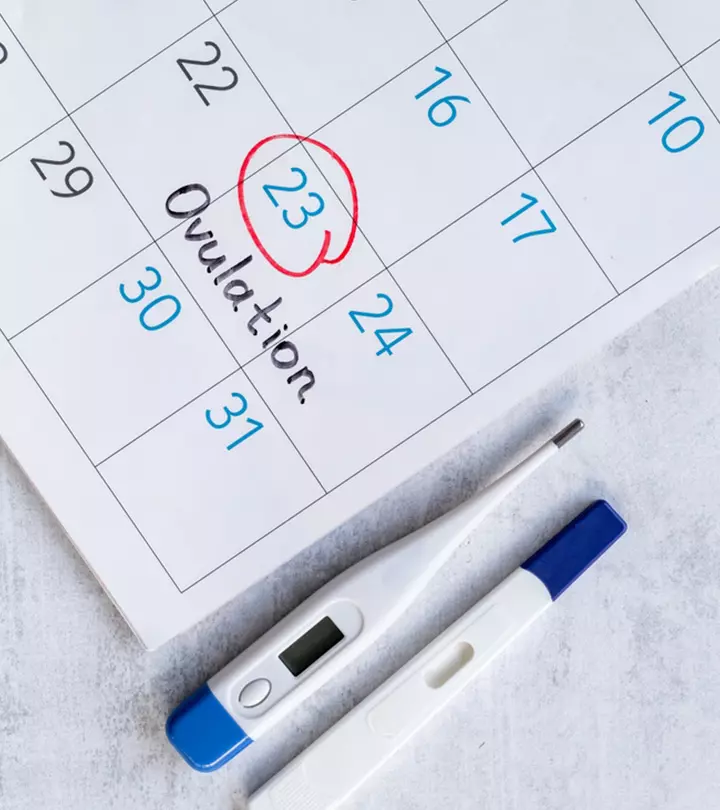
Image: Shutterstock
A woman’s body operates on a fascinating monthly rhythm known as the menstrual cycle. It is a finely tuned sequence lasting roughly 28 days. It’s not just about preparing for pregnancy; think of it as a complex system within your body. This cycle is a testament to your overall health and well-being, showcasing your body’s ability to renew itself regularly. Understanding this process not only sheds light on fertility but also empowers you to take charge of your reproductive health. It offers insights into your body’s incredible capabilities. Read on to know more!
Phase 1: Menstruation
At the start of your cycle, you will bleed through your vagina – that’s your period. It usually lasts around 3 to 7 days. During this time, your body is shedding the lining of the uterus, getting ready for a new cycle.
Phase 2: The Follicular Phase
Once your period ends, your body gears up for ovulation. This phase begins with the brain releasing hormones that prompt your ovaries to produce eggs. Around this time, your uterus starts getting ready to host a fertilized egg.
Phase 3: Ovulation
Image: Shutterstock
This is the highlight of your cycle! Ovulation is when your ovary releases an egg. This usually happens around the middle of your cycle, roughly 14 days before your next period. Your body temperature might slightly increase during this time.
Phase 4: The Luteal Phase
After the egg is released, your body gets ready for either pregnancy or another cycle. The released egg travels down the fallopian tube, and if it meets sperm, it might get fertilized. If not, it dissolves. Your uterus keeps thickening its lining to prepare for a possible pregnancy.
Signs Of Ovulation
You might notice a few signs when you’re ovulating. Some women feel a slight twinge of pain in their lower abdomen called mittelschmerz (1). Also, your cervical mucus might become clearer and stretchier, kind of like raw egg whites.
When Do You Ovulate?
Image: Shutterstock
Most women ovulate around the middle of their cycle. But everyone is different! Some might ovulate earlier or later in their cycle. Keeping track of your cycle can help you figure out when you’re ovulating.
Cycle Variations
Not everyone’s cycle is 28 days long. It can be shorter or longer. Some women have irregular cycles, which means their cycle length changes from month to month. Stress, illness, or certain medical conditions can affect your cycle (2).
Fertile Window
Your fertile window is the time when you’re most likely to get pregnant. It usually spans a few days around ovulation. If you’re trying to conceive, this is the time to aim for!
Tracking Ovulation
Image: Shutterstock
There are various ways to track ovulation. Some use ovulation predictor kits that check hormone levels in urine. Others keep tabs on their body temperature or the changes in cervical mucus. Apps and calendars can also help predict ovulation based on your cycle data.
What If You Don’t Want To Get Pregnant?
If pregnancy isn’t on your agenda, knowing your ovulation cycle is crucial for birth control. Avoiding sex or using contraception during your fertile window can help prevent pregnancy.
Ovulation Cycles As Health Indicators
Image: Shutterstock
Your monthly ovulation cycle isn’t just about fertility — it’s a mirror reflecting your overall health too. Irregularities, such as unpredictable cycles or absence of ovulation, can hint at underlying health concerns. These irregularities might be subtle signals of hormonal imbalances or potential health issues that warrant attention. By observing and noting changes in your cycle, you gain valuable clues about your body’s internal balance.
- Hormonal Imbalances And Irregular Cycles
A regular ovulation cycle depends on a delicate balance of hormones. Any disruptions to this equilibrium can manifest as irregularities in your cycle. For instance, conditions like polycystic ovary syndrome (PCOS) or thyroid disorders can disrupt ovulation, causing irregular menstrual cycles (3). Recognizing these signs can prompt timely intervention and management of these conditions.
- Consulting A Healthcare Provider
When your ovulation cycle deviates from its typical pattern, seeking guidance from a healthcare professional becomes crucial. Consulting with a doctor or gynecologist can help decipher these irregularities. It’s a proactive step toward identifying the root cause of any disturbances and taking appropriate measures to restore your body’s natural rhythm.
Empowerment Through Understanding
Image: Shutterstock
- Insight Into Reproductive Health
Understanding your ovulation cycle offers more than just fertility insights. It’s a fundamental aspect of your reproductive health. By tracking your cycle, you gain a deeper understanding of your body’s rhythm and its reproductive processes. This awareness doesn’t only aid in family planning but also enables you to take charge of your reproductive health.
- Tools For Body Awareness
Keeping track of your cycle equips you with a powerful tool for self-awareness. Whether you aim to conceive or manage your overall well-being, monitoring your cycle provides valuable data. Apps, calendars, or even simple jotting down of dates and symptoms can offer a clearer picture of your body’s patterns and deviations, facilitating informed decisions about your health.
Recognizing irregularities or deviations from the norm empowers you to take proactive steps towards your well-being. By understanding and tracking your cycle, you unlock the key to better reproductive health and a deeper connection with your body’s natural rhythms.
















